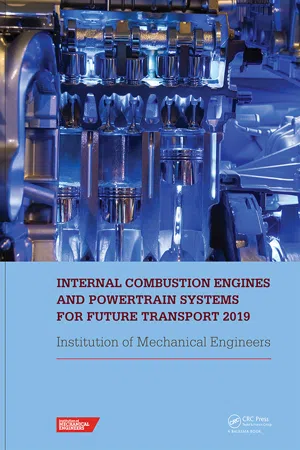
- 336 pages
- English
- ePUB (mobile friendly)
- Available on iOS & Android
About This Book
With the changing landscape of the transport sector, there are also alternative powertrain systems on offer that can run independently of or in conjunction with the internal combustion (IC) engine. This shift has actually helped the industry gain traction with the IC Engine market projected to grow at 4.67% CAGR during the forecast period 2019-2025. It continues to meet both requirements and challenges through continual technology advancement and innovation from the latest research. With this in mind, the contributions in Internal Combustion Engines and Powertrain Systems for Future Transport 2019 not only cover the particular issues for the IC engine market but also reflect the impact of alternative powertrains on the propulsion industry. The main topics include:
• Engines for hybrid powertrains and electrification
• IC engines
• Fuel cells
• E-machines
• Air-path and other technologies achieving performance and fuel economy benefits
• Advances and improvements in combustion and ignition systems
• Emissions regulation and their control by engine and after-treatment
• Developments in real-world driving cycles
• Advanced boosting systems
• Connected powertrains (AI)
• Electrification opportunities
• Energy conversion and recovery systems
• Modified or novel engine cycles
• IC engines for heavy duty and off highway
Internal Combustion Engines and Powertrain Systems for Future Transport 2019 provides a forum for IC engine, fuels and powertrain experts, and looks closely at developments in powertrain technology required to meet the demands of the low carbon economy and global competition in all sectors of the transportation, off-highway and stationary power industries.
Frequently asked questions
Information
SESSION 1: INTERNAL
COMBUSTION ENGINES
AND COMBUSTION
ELEMENTS
Assessing the low load challenge for jet ignition engine operation
ABSTRACT
1 INTRODUCTION
1.1 Background
1.2 Jet ignition
Table of contents
- Cover
- Half Title
- Title Page
- Copyright Page
- Table of Contents
- Preface
- Organising Committee
- SESSION 1: INTERNAL COMBUSTION ENGINES AND COMBUSTION ELEMENTS
- SESSION 2: HYBRID APPLICATIONS
- SESSION 3: EMISSIONS AND AFTER-TREATMENT
- SESSION 4: FUELS AND FUEL INJECTION
- SESSION 5: INCREASING EFFICIENCY AND REDUCING EMISSIONS
- SESSION 6: INTERNAL COMBUSTION ENGINES
- SESSION 7: SIMULATION OF INTERNAL COMBUSTUION ENGINES
- SESSION 8: DESIGN AND DEVELOPMENT OF INTERNAL COMBUSTION ENGINES
- Author index